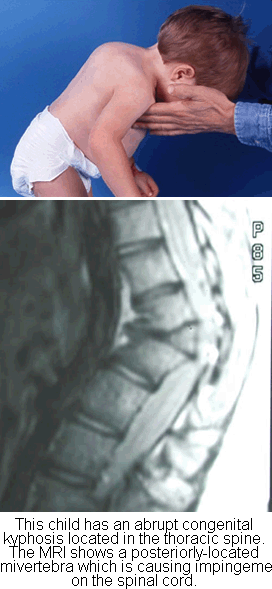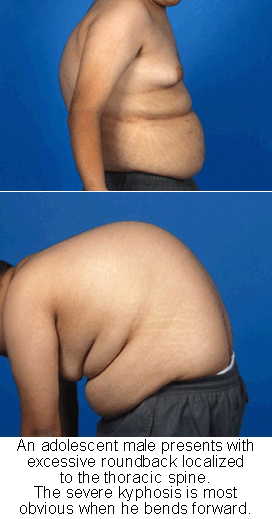Kyphosis (Curvature of the Spine)
These articles are for general information only and are not medical advice. Full Disclaimer. All articles are compliments of the AAOS
Description
Few things bother parents more than their child’s posture. This is particularly true for an exaggerated rounding to the back. Some degree of curvature to the spine is normal. The term “kyphosis” (kI-fO-sis) is usually applied to the curve that results in an exaggerated “round-back.” A variety of disorders may be responsible for this condition. Several are listed below.
Usually, a visit to the doctor is brought on by a scoliosis screening at school, concerned about the cosmetic deformity of a rounded back or pain combined with poor posture. The doctor may ask the child to bend forward so that he or she can see the slope of the spine. X-rays of the spine will show if there are any bony abnormalities. X-rays will also let the doctor measure the degree of the kyphotic curve. Any kyphotic curve that is more than 50 degrees is considered abnormal.
Types of Kyphosis
Postural Kyphosis
Postural kyphosis is the most common type. It is often attributed to “slouching.” It represents an exaggerated, but flexible, increase of the natural curve of the spine. This usually becomes noticeable during adolescence. It is more common among girls than boys. It rarely causes pain. Exercises to strengthen the abdomen and stretch the hamstrings may help take away associated discomfort. But exercises probably won’t result in significant correction of the postural kyphosis. This condition does not lead to problems in adult life.
Scheuermann’s Kyphosis
Scheuermann’s (shoe-er-mans) kyphosis is named after the Danish radiologist who first described the condition. Like postural kyphosis, it often becomes apparent during the teen years. However, Scheuermann’s kyphosis will present with a significantly worse cosmetic deformity. This is particularly the case in thin individuals. Scheuermann’s kyphosis usually affects the upper (thoracic) spine. It can also occur in the lower (lumbar) back area. If pain is present, it is usually felt at the apex of the curve. Activity can aggravate the pain. So can long periods of standing or sitting. Exercises and anti-inflammatory medication help ease the discomfort. When X-rays are examined, the vertebrae and disks will appear normal in postural kyphosis. But they are irregular and wedge-shaped in Scheuermann’s kyphosis.
Congenital kyphosis. In some infants, the spinal column does not develop properly while the fetus is still in the womb. The bones may not form as they should. Several vertebrae may be fused together. Either of these abnormal situations may cause progressive kyphosis as the child grows. Surgical treatment may be needed at a very young age. This can maintain a more normal spinal curve. Consistent follow-up is required to monitor any changes.


Treatment Options
Treatment will depend on the reason for the deformity. Most teens with postural kyphosis will do well throughout life. In some, their posture may improve over time. An exercise program may help with back pain if present.
An initial program of conservative treatment is also recommended for patients with Scheuermann’s kyphosis. This includes exercises and anti-inflammatory medications. If the child is still growing, the doctor may prescribe a brace. The child wears the brace until skeletal maturity is reached.
Treatment Options: Surgical
Surgery may be recommended if the kyphotic curve exceeds 75 degrees. The goals of surgery are:
- Reduce the degree of curvature by straightening and fusing the abnormal spinal segments together
- Maintain the improvement over time
- Alleviate back discomfort, if present preoperatively
